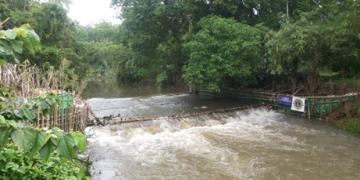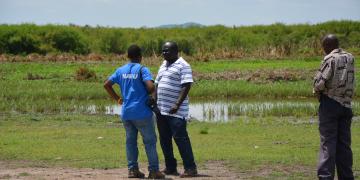
Community stewardship for conservation in Western Arunachal Landscape,India
Full Solution
Community dialogue for CCA declaration
WWF-India
Community Conserved Areas (CCAs) formed with the help of WWF India in Arunachal Pradesh have helped local communities to better manage forests. Factors such as excessive use of forest resources and setting up of large infrastructure projects have led to forest loss across the region. CCA have helped reverse this trend with local communities setting aside large portions of the forest as conserved area and managing these areas for conservation and sustainable livelihood purposes.
Last update: 02 Oct 2020
7118 Views
Context
Challenges addressed
forest loss/ degradation, hunting, large-scale infrastructure developments
Two-third of forest cover of the state falls outside PAs and de-facto remains under control of local communities. It harbours an assemblage of wildlife including threatened species. Traditional forest management practices are gradually eroding leading to unsustainable harvest of forests further compounded by development of large-scale infrastructure projects resulting in biodiversity loss.
Location
Western Arunachal Landscape, Arunachal Pradesh, India
South Asia
Process
Summary of the process
Recognizing the fact that large tracts of the forest are under community jurisdiction and are continuously being affected by forest loss and degradation, a community-based approach to arrest the loss of forests, associated biodiversity and linked livelihoods was envisaged.
Key to ensure that a community based initiative becomes successful was the recognition that the process is democratic, participatory and inclusive in nature. A necessary and desirable outcome of this is a sense of ownership across the community. Institution building is key to sustaining the processes leading to forest and biodiversity protection. Given growing aspirations of local communities, especially youth, the need for incentivizing conservation through sustainable livelihood options including community based tourism is crucial. The entire community-based conservation process and finally, putting up a management plan through participatory approach helps long-term conservation of forests under community jurisdiction.
Building Blocks
Collective decision through participatory process
The participatory community decision-making process is the crux of effective community-based conservation. It entails community dialogue and periodic village-level consultations with different community segments i.e. village headman (Gaonburah), elders including key decision makers, women and youths. WWF-India approached the communities in western Arunachal Pradesh to keep aside a certain proportion of their rich community forests as a conserved area without compromising on the traditional right to access and use and at the same time arrive at a consensus on how to protect and manage the area for biodiversity conservation. This effort included meetings with village headmen/ key decision makers for clarification of the CCA concept, taking other villagers into confidence through numerous meetings and community/public dialogues, biodiversity documentation through research and studies, arriving at rules and regulations and finally, physical demarcation of conserved areas for effective management.
Enabling factors
• Winning trust of the community
• Recognition and willingness on the part of community and other key stakeholders that forest and biodiversity loss is a problem that needs to be addressed and solutions to these include community led restoration processes.
Lesson learned
Regular community interactions/ focused discussion are one of the key components of the community-based conservation. Trust building is important especially given that the forests are under de-facto community jurisdiction whereas the administrative position on these is at best ambiguous. Consultative processes with the community need to keep in mind that what may appear to be an outwardly homogenous community may not be really so. Widespread buy in from the entire community for the CCA is vital as the rules for access and use determined by the community necessarily impose restrictions and demand behavioral change from members. Moreover for the benefits to be evident these would need to sustain over the long term.
Institution Building by setting up CCA Management Committees
Institution building is key to ensuring the success and sustainability of the CCA initiative. The CCA Management Committee (CCAMC) is based on the principle of universal membership i.e. every adult of the village (or villages, if the conserved area falls under two or more villages) is a member. The CCAMC formation process takes its own course of time; the general assembly selects an executive body. The management committee in most instances comprises 20 executive members representing different segments from within the community with a core committee (comprising seven members). The core committee in consultation with the management committee and the general assembly is responsible for drafting the rules and regulations for the management of the conserved area, planning appropriate livelihood interventions, preparation of the management plan and its implementation. The executive members are selected for a period of three years.
Enabling factors
- Adherence to the principle of universal membership
- Process of collective dialogue and decision making
Lesson learned
In the absence of universal membership and widespread consultative processes and collective decision making the institution formed in this instance the CCAMC will be rendered weak and lack the required legitimacy within the community. With no institutional arrangement along with the required capacity in place the forest protection and management initiative by the community is unlikely to sustain. The institutional processes need to be dynamic and evolve with time; it cannot be a onetime exercise.
Resources
Participatory mapping and demarcation of conserved area
Demarcation of the conserved area is a crucial step, and involvement of the entire community in this process is extremely important. The area under de facto community jurisdiction is quite large even going up to a few hundred square kilometers in some cases, there are also disputed lands either between various clans of the village or between different villages. It is important that the community reaches a consensus on how much and which area will be declared as a conserved area.
Using participatory tools i.e. social/ resource mapping, we identify landmarks and traditional boundaries of the forest and physically verify them wherever possible. We also use modern devices like GPS to track/ mark boundary/ make use of Google Earth and develop maps using GIS. This helps to define boundaries and outline a map of the conserved area, and communicate this to all stakeholders and especially each and every household of the village. Well defined boundaries are the foundation for better protection and long-term management.
Enabling factors
- Widespread consultation with the community to arrive at a consensus on the area to be conserved
- Validation by key stakeholders of the area proposed to be declared as CCA
Lesson learned
It needs to be ensured that the entire community is onboard and accepts the demarcation and landmarks well during the boundary marking/ demarcation process of a conserved area. Special emphasis needs to be put on involving all land owners (individual or clans), forest user groups, herders and other influential persons of the village. In the absence of this a section of the community could question the legitimacy of both the CCA and the processes undertaken towards its declaration and demarcation.
Community-based tourism: economic incentive for conservation
After initial assessments to determine what could be the most appropriate livelihood activities that would further encourage conservation action in the landscape, the Community-Based Tourism (CBT) plan was developed and the community was trained to run the programme. The CBT programme comprises promotion of home-stay units, home restaurants for food, a cultural group to showcase Monpa art and culture, organized treks through the conserved areas and provision of trained service providers (guides, managers, cooks, porters, etc) to support all of these. The community has sought to include as many families as possible in the programme so as to ensure spread of programme benefits. The CBT in Thembang, one of the project villages, is now in its seventh year with revenues increasing four-fold since inception, amounting to 23,000 USD as of March 31, 2015. The CBT was successfully replicated in other project villages based on biodiversity values.
In similar line, WWF-India is also diversifying income generation activities to other forms of rural enterprises for conservation impacts. Recently, it facilitated the process to establish a unit to manufacture Tibetan incense stick with available forest resources in Pangchen valley.
Enabling factors
Baseline information is collected on various parameters including family income and energy usage to decide suitable activities. The baseline report also helps to assess our intervention impacts and
• Awareness/ conservation education programmes for larger community to enable a thorough understanding of what CBT entails.
• Community willingness to actively participate, acquire the knowhow and implement the required actions.
• Unique selling points in terms of cultural and biodiversity values to attract people for the CBT model to be sustainable.
Lesson learned
A detailed participatory assessment is very crucial in the implementation of any income generating activities (IGAs). The IGAs should be developed jointly with community members rather than in a “top down approach” and encourage communities to take up activities they are familiar with. We encouraged IGAs that have direct linkages with the nature conservation and culture.
Participatory planning and ensuring people’s participation is very important in livelihood interventions. For conservation impacts, there should be a direct link between nature conservation and livelihood initiative. There are some economic incentive programmes that have been successful in raising per capita income of the community, but have had very little conservation impact, or sometimes conservation status even deteriorates. Therefore, identification of a proper set of IGA and enabling people’s participation is the key of success.
Resources
Participatory CCA monitoring
The pressures of hunting and logging are gradually mounting in most of the forest areas resulting in forest degradation and decline in wildlife. In this backdrop, community conserved areas become attractive targets for certain segments of the village community and people from neighboring villages involved in illegal hunting of wildlife and exploitation of natural resources. There are also poaching reports of musk deer for glands (or musk pods) and the Himalayan black bear for gall bladder, paws and skins. Though management committees of the respective community conserved area frame the rules and regulations preventing hunting, illegal logging and over extraction of medicinal plants or associate non-timber forest products, continuous monitoring is needed to ensure that these are implemented.
Keeping this issue in mind, the management committee identifies at least ten youths who are responsible to patrol their conserved area following human/ animal trails, monitor illegal movement of any suspect, dismantle traps and collect periodic data on biodiversity. This component helps monitoring forest and wildlife as well as record biodiversity information on the conserved area supporting future management planning.
Enabling factors
- Identification of villagers who are competent for tracking and well informed on the forests. The herders/hunters are resourceful and well fit for the job
- Financial supports for camping gear, equipment and operational costs
- Ensuring the forest authority is informed for legitimacy of the actions, legal support for wildlife confiscation/ registering case in case of convictions
- Ensure community supports this.
Lesson learned
Even though the community undertakes patrolling and monitoring on their own, this effort needs regular capacity building inputs. Support from forest authority, legal awareness through regular capacity building programme on various parameters i.e. provisions under law for wildlife confiscation, registering a case for any instance of conviction and judicial support need to be ensured for optimal results.
Before implementation of this component, it is important to make sure that the community understands legal issues; that they are supported by the forest authority, and receive basic training on how to handle equipment, collect and compile data for biodiversity monitoring.
Participatory management planning and capacity building
Participatory management planning and capacity building of locals for long-term conservation of forests is one of the final steps of the community-based conservation model. Developing a participatory management plan helps communities to manage their forests effectively. Recently, we drafted a management plan for one of the conserved areas, using participatory decision making tools to identify different units of land-use, human-used areas for basic livelihood needs, grazing grounds and their associated values related to the biodiversity and livelihoods of the community. Through participatory tools, we identified areas where conservation action is needed, areas for regeneration and some of the pockets that needs better protection through the patrolling and monitoring. We undertook social mapping ensuring participation from all segments of the community i.e. elders having knowledge on village history/natural resources, herders, headman (gaonburah), women and youths to delineate all forest usage units. Once forest units and associated actions were identified, we outlined a budget and identified funding sources to support these planned endeavors. The management plan is valid for a period five years, and will be reviewed annually.
Enabling factors
- Baseline information on various use forms and quantification of natural resource use for livelihood
- Identification and involvement of all segments of the community especially elders, key decision makers, influential members of the community, youths and women
- Identify different resource user/ user groups i.e. herders, prospective farmers, hunters (former hunters), traditional healers, etc
- Involvement of local authorities including forest department and district administration for leverage and convergence
Lesson learned
Enabling development of a participatory management plan ensures sustainability of a conserved area. Effective management planning and its implementation helps protect biodiversity as well as ensure long-term sustainable livelihoods. The community and the management committee of the conserved area in particular should feel the need and have ownership in preparing a management plan. Otherwise, it will be merely a document. We have undertaken numerous conservation education events with different segments of the community and involved them in participatory discussion. These programmes help raise their interest and clarify conservation linkages to their day to day livelihood. We have also taken enough time during our participatory appraisals ensuring optimum participation from the community segments.
Impacts
1. The CCA maintain ecosystem services while securing key wildlife habitats (the CCA covers significant habitat of red panda, Himalayan goral, serow, mishmi takin, marbled cat and contains high altitude lakes). Since 2007, community members have voluntarily declared four CCAs, which together cover an area of roughly 1,000 km2 of forests.
2. The CCA model and approach has been successfully endorsed by the government of Arunachal Pradesh. Collaboration with developmental agencies including line departments at district, state and national levels have been integral part of this effort. Apart from substantial support that this project received from the state, one of the CCA management committees now receives an independent three-year long grant ($ 40,000) from the Department of Science & Technology, Government of India to strengthen its work.
3. The Community-based Tourism (CBT) initiative in Thembang, one of the CCAs, is now in its seventh year with revenues increasing four-fold since inception, amounting to $ 23,000 as of March 31, 2015.
Beneficiaries
Local communities (Monpa, Shertukpen), 14 villages, ~400 households
Story
Changing attitude towards conservation:
The community-based conservation model has had an organic growth over last one decade. Today, there are roughly 1,000 sq km of pristine forests fall under this management regime where community decides management rules and implements protocols on sustainable resource harvesting practices. These changes have come throughout the years of rigorous and regular engagement with the local community. “We have been working very hard to conserve the red panda, the black-necked crane and to preserve forests for our future generation” said Rinchin Wangdi, one of the executive members of Pangchen Lakhar CCA management committee while attending an award function held recently. “The award is a prize but we will also take this as a responsibility to perform better” he added.
This positive attitude of the community has come over the period of time with successful implementation of CCA processes and with due recognition and appreciation. This positive vibes reflect in other villages too. Recently, the Socktsen village, one of the villages of the valley, came forward to declare some of their pristine forest as CCA. The villagers decided to undertake this conservation initiative after experiencing the model of their neighbouring villages. Ironically, this is the same village that has refused to take part of the conservation initiative way back 2011 with a suspicion notion that this will lead to alienation of their rights over natural resources and forests. Of late, this has been clarified, understood and finally, the villagers decided to declare their own conserved area and set up a management committee.
This is the tip of the iceberg and there are many instances of how the people have shown their positive attitude towards conservation in the landscape. “We have been sighting red panda since our childhood but barely had any special feeling about it. If someone would have hunted a red panda before, it would least bother me. But, today, my perspective on red panda is changed, I feel pride and concern about them and of course, I will not let anyone hunt or let hurt them” Lham Tsering expressed his feeling about the red panda in one of our field conversations. Lham Tsering is one of the local community members undertaking red panda survey in Zemithang valley in a couple of years now. This model has already touched few hearts however there is a long way to go to make really a difference.




